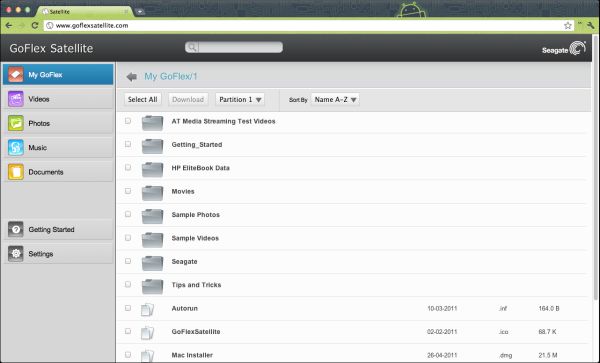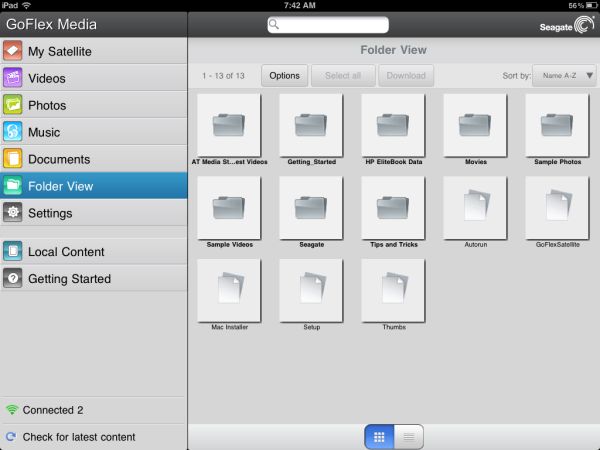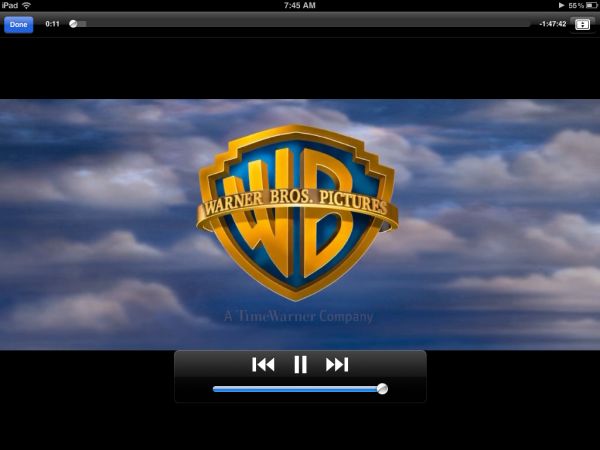Understanding Wireless Storage: Kingston Wi-Drive and Seagate GoFlex Satellite
by Vivek Gowri on November 21, 2011 2:30 PM ESTSeagate's Satellite iOS, Android, and Browser Apps
Seagate gives you more options than Kingston when it comes to connections—the Satellite has a webserver built in that you can connect to from any device that has a browser. Turn the Satellite on, wait for it to show up in the list of available networks, and connect. This is standard stuff, and it doesn’t matter what device you’re using.
Now if you’re trying to connect from a PC or Mac, just open up a browser window, enter any random URL, and it’ll redirect to the GoFlex Satellite webapp (url: www.goflexsatellite.com). You get a GUI with the file system, as well as filtering files by type—videos, photos, music, and documents. There’s also a "Getting Started" page that contains all the documentation and help files, as well as a settings menu. Inside the settings page, you can reboot or shutdown the device, change the SSID, enable WPA security, or reset the settings to default.
The iPad app is pretty similar to the webapp, except with the additional option to play back local content; the Android app looks identical to its iOS counterpart in every way. It’s nice to have a unified UI over all three platforms; it keeps the user experience consistent and overall Seagate has done a good job to make this feel like a cohesive software platform.
Unfortunately, all three options don't give you the same experience when it comes to playing back media. Photos and music are pretty much old hat, and all three platforms handle them with ease. When it comes to video playback, things start to diverge. The iOS app is by far the most seamless, playing every video the iPad supports with no problem regardless of bitrate or file size. The Honeycomb app works similarly in terms of file compatibility, but it does some weird things with the playback—the media player will sometimes forget it’s streaming from a webserver and try to download the file. That's definitely not what I had in mind. The browser player is better than I expected, but it struggles with higher bitrate HD movies and stuff encoded in x264—and by struggles, I mean they flat out refused to play, so that wasn’t useful. Overall, the in-browser webapp works pretty well as long as you make sure the files you’re trying to play are compatible first.













32 Comments
View All Comments
Glibous - Monday, November 21, 2011 - link
I really like how the WD product looks but as you said in the first page...looks like a re-purposed iPhone 3G. It is very similar. I'm just hoping Apple doesn't find a way to use that in another patent war. I don't think WD has the same capital as Samsung to fight them off..Impulses - Monday, November 21, 2011 - link
These things would be irrelevant if Apple included microSD slots and/or USB slots into their devices. 32GB Class 4 cards from Sandisk can easily be found for $35.Almost every Android tablet can be connected to a portable USB HDD or any thumbdrive with a USB OTG cable; or an extra adapter in the case of tablets like the Galaxy 10.1 and TF which lack USB w/o a dock and only have the propietary charging ports on board ($10 adapter converts that to USB). Even some phones can use OTG USB cables to hook up HDDs, gamepads, etc.
Just saying...
Johnmcl7 - Monday, November 21, 2011 - link
This is exactly what I was thinking when reading the article and surprised none of it is mentioned, I can certainly see why these devices may be useful for Apple owners but less so for Android over time. I currently have a Galaxy Note so if I was needing more storage I can either pop in a micro SD card (or have multiple and swap between them) or simply plug in a standard USB flash drive or hard drive through USB OTG.John
melgross - Monday, November 21, 2011 - link
Honestly, most other companies use SD slots so they can cheap out on the memory they offer. Often when buying one, it comes with even less memory than the lowest memory version of the Apple device, forcing you to buy more just to get even.In addition, when you rely not hat, as I did with my Treo 700p, you find that your always changing out cards, because you have different things on each card. With bigger cards these days that's less of an issue, but it still exists. And it's only now that Google is making storage on cards the same as internal storage. Truth is, that's been a bitch.
The only annoying thing about the way Apple does it is to not allow mass storage directly in USB. But then, do you really want external storage dangling off your device? I don't.
The improvement to the Kingston that I would like to see is for it to not have any internal storage, but to have a UDMA 7 CF slot instead.
medi01 - Monday, November 21, 2011 - link
BS.Most other companies do not have loyal fun base that is eager to pay 100$ per 16Gb "extra" memory.
Same goes for your "often" argument. Most Android tablets start with 16Gb AND have micro SD slot.
medi01 - Monday, November 21, 2011 - link
I wish I new which device with micro SD card support has it "dungling out of the device". Maybe ifanboi need to look around.inplainview - Monday, November 21, 2011 - link
What? Could not quite comprehend the insult you were trying to throw. Try again please.inplainview - Monday, November 21, 2011 - link
I know you from AI mate. How's things and your arguments are spot on here as over there.Johnmcl7 - Monday, November 21, 2011 - link
The Note offers either 16GB or 32GB (more than the base Apple devices) and as it supports 64GB (and more beyond) SDXC cards that takes its capacity beyond the largest Apple offer and my last phone was 32GB onboard and microSD expansion. And as SDXC cards expand, it's likely the Note can take more memory than the next Iphone as well. Google is not making internal the same as external, that's up to the handset manufacturers and it's not uniform across Android devices. I don't see your Treo example as relevant as the market has changed substantially in the many years since it was released.As for devices hanging off the devices, if it's sitting docked or similar (which is where I'd be using a storage device) then I wouldn't mind having a cable coming off it just as I have no problem running it with headphones attached.
Plus at worse if I really want to use a wifi storage devices as reviewed here, I still can. However it's not been a problem previously and doubt it will be now
sethiol - Monday, November 21, 2011 - link
Ditto. Just one more reason why I tend to avoid most Apple products.